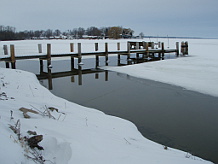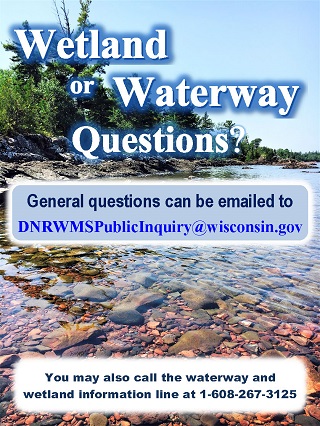Avoid ice damage on permanent structures
Waterway protection

When boating season is over, many choose to winterize piers, docks and other structures by putting them into storage. Heaving ice and ice buildup can dislocate pilings, footings and structures. The best way to avoid these impacts is to remove the structures from the water prior to freezing conditions. Some steps can be taken to help lengthen the structural life of permanent structures placed in water. It is important to determine if DNR permitting or other permitting at the local, county or federal level are necessary. As a general rule of thumb, additional DNR permits are required if you are placing a structure in the water or disturbing the lake or river bottom. Applicants are responsible to check with local county zoning staff to seek applicable county permits.
Ice management systems cannot adversely impact the public or neighbors who may be accessing the lake near the waterfront. This means that that ice management systems cannot impact the ice on your neighbor's property nor can they create unsafe ice conditions for ice skaters, fishermen, snowmobilers, etc. If ice holes are created, they must mark them with either a barricade or a visual warning mechanism or both. Please refer to the aerator factsheet for more information.
- Aerators
-
Aerator systems typically require placing a single base or tubular structure on the lakebed to push air through the water column so that water is continually moving, avoiding stagnant water flow conditions and ice buildup. This can adversely impact other riparian owners and members of the public by pushing ice elsewhere on the lake causing larger ice problems downstream. Although the department does not advocate for aerators, a permit is not required to install or maintain these devices so long as the following conditions are met.
- The aerator is attached to a legal structure that has either received a permit or is exempt from needing a permit;
- the mixing action does not disturb the lake bottom;
- the aerator does not cause problems for lake users or neighbors; and
- all ice holes created are clearly barricaded and/or marked.
In some cases, the owner may be required to install a snow curtain to limit the water mixing to their riparian zone to avoid unsafe ice conditions for neighbors or the public. If one of these factors cannot be met, a miscellaneous structure permit is required for these systems. Please refer to the aerator factsheet for more information.
- Mixing prop or other mixing devices
-
A mixing prop is a propeller suspended in the water column that moves water and ice laterally away from a localized area. These props are typically attached to another structure such as a pier, wharf, boom or float. Although mixing props can push ice buildup away for existing structures, they can cause significant problems for downstream riparian owners that may receive compounding ice densities from the prop. They can also create unsafe ice conditions or open water holes in the ice that can be a navigational hazard. It is imperative that all ice holes are well marked and/or barricaded to ensure public safety. Although the department does not advocate for mixing props, a permit is not required to install or maintain these devices so long as the following conditions are met.
- The prop is attached to a legal structure that has either received a permit or is exempt from needing a permit;
- the mixing action does not disturb the lake bottom and the discharge jet is below the water surface;
- the prop does not cause problems for lake users or neighbors; and
- all ice holes created are clearly barricaded and/or marked.
In some cases, the owner may be required to install a snow curtain to limit the water mixing to their riparian zone to avoid unsafe ice conditions for neighbors or the public. If one of these factors cannot be met, a miscellaneous structure permit is required for these systems.
- Pilings
-
Pilings can be placed for the purpose of deflecting ice to protect an existing or proposed structure. These structures can also serve as a pivot point for turning watercraft. A pilings general permit has been created to streamline the permitting process for these structures.
- Submerged thrusters
-
Submerged thrusters involve placing a submersible motor that draws warmer water from the depths of a pond or lake towards the surface to prevent ice buildup. These types of deicing devices do not work well in shallow waters or waterbodies that lack a thermocline. These devices can also have potential risks to water quality and water clarity by releasing nutrient-rich water to the water surface. For this reason, a miscellaneous structure permit is required for these systems. These systems also create holes in the ice so it is imperative that these are well marked and/or barricaded to ensure public safety. Please refer to the aerator factsheet for more information.

